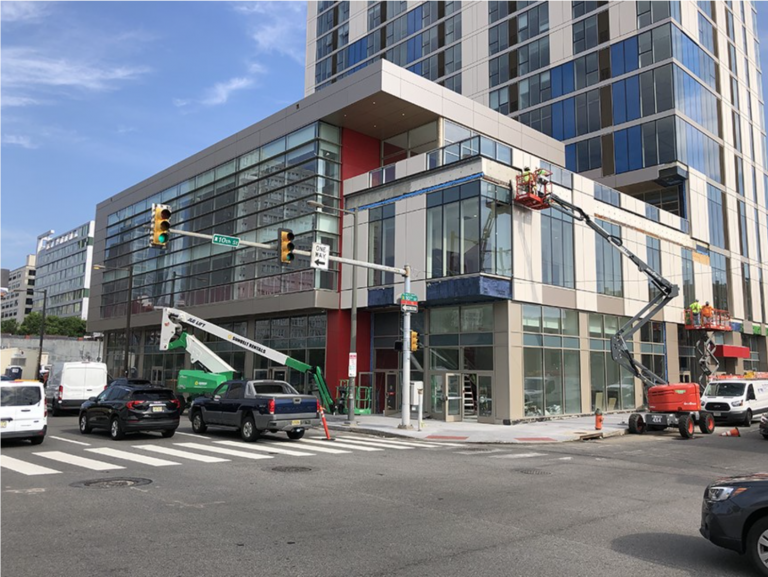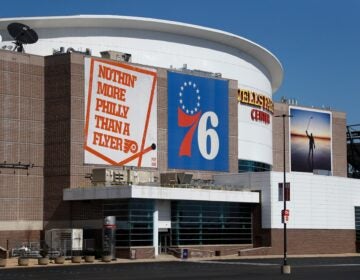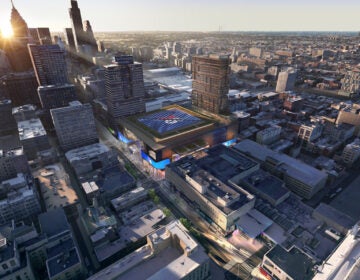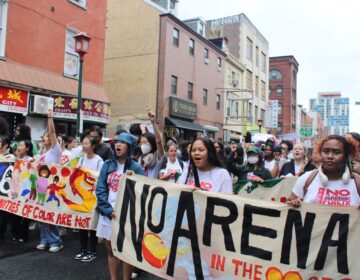Chinatown CDC is marketing the ‘hood’s tallest tower as a $67 million lux address
The project was originally planned with an affordable housing component, but is now being pitched to investors as a luxury property.

Construction on the Crane, pictured, is nearly complete. (PCDC Rittenhouse Realty Advisors)
This article originally appeared on PlanPhilly.
—
The Philadelphia Chinatown Development Corporation is marketing the neighborhood’s largest residential tower for sale.
It took PCDC eight years to complete “The Crane,” a 20-story tower and community center just north of Interstate 676. But the project, which was originally planned with a sizable affordable housing component, is now being pitched to potential investors as a luxury property that could bring in rents between $1,900 to $3,500 per unit.
Although construction is still wrapping up, the nonprofit has already begun showing the 150-unit apartment component to real estate interests. The asking price is $67 million.
In a sales packet prepared by Rittenhouse Realty and obtained by PlanPhilly selling points include “spacious residential units” with stainless steel appliances, granite countertops –– and proposed monthly rents ranging from $1,900 for a studio, $2,600 for a one-bedroom or $3,200 for a two-bedroom unit. These rents are about $500 a month higher than pre-leasing prices offered to tenants who are in the process of moving into the building.
A community center and retail component built as part of the project are separate properties and would not be included in a sale.
John Chin, director of PCDC, said the tower’s development was part of his organization’s goal of expanding “Chinatown North” by guiding more residential development into a historically industrial area above the submerged highway, which cuts the Chinatown neighborhood in half. He said any future sale of the building would be in keeping with that goal.
“Chinatown is a heavily commercial area with lots of residences above storefronts,” he said. “We wanted to build a residential presence north of 676,” he said. “These are market-rate prices. They’re for anyone who wants to live in Chinatown.”
However, the ZIP code encompassing Chinatown has historically been home to many newly-arrived Asian immigrants and has a poverty rate of 26.8% –– a prevalence that helped make The Crane eligible for EB-5 investment programs intended for “distressed communities.” The proposed rent schedule would make the units ideally priced for residents earning $72,000 a year or more, much higher than the city’s $41,000 median household income.
But Chin said the development could attract residents and wealth that would support nearby immigrant-owned businesses. The project, built on land purchased from the Philadelphia Redevelopment Authority for $776,000 is the largest in budget and scope built in Chinatown to date, according to Chin’s group.
“We need to build a residential base in order to sustain our commercial corridor. The project isn’t about sustaining PCDC. It’s about supporting the neighborhood,” he said. “As much as non-CDC people and developers want to keep us in our lanes, it’s about more than just building affordable housing … It’s our duty as a CDC. I would debate anyone on this.”
On the organization website, it describes the project as “designed to address the recreation, housing and services needs of a growing community of both residents and Asian immigrants from the Philadelphia region.”
Chin suggested the tower, which benefited from a $5 million state development grant, could be a home for Chinatown’s upwardly mobile residents.
“My parents came here as immigrants and were part of that 26 percent,” he said. “They worked hard, along with our neighbors, to get out of poverty.”
The group recently clashed with the nearly Callowhill Neighborhood Association over competing plans to launch a neighborhood business improvement district. Critics said the Callowhill group’s plan favored mostly white newcomers and would intensify gentrification. Chin had criticized the neighborhood association for failing to emphasize affordable housing in their plan.
Initially, PCDC planned to set aside nearly a quarter of the units in the tower for affordable housing. But during a long and complex process of assembling funding for the development, the plans were largely scrapped. Only three units of affordable housing survived the planning process, and PCDC said they would be preserved as part of any sale arrangement.
Chin stressed that a sale was not imminent and that his group had engaged Rittenhouse Realty principally as “an exercise in seeing what the building is worth.” However, he also indicated that several real estate investors had already toured the building. PCDC staff, like business development manager Anne Martin-Montgomery, indicated they were unfamiliar with the marketing effort.
The Crane sales prospectus by Ryan Briggs on Scribd
WHYY is your source for fact-based, in-depth journalism and information. As a nonprofit organization, we rely on financial support from readers like you. Please give today.







